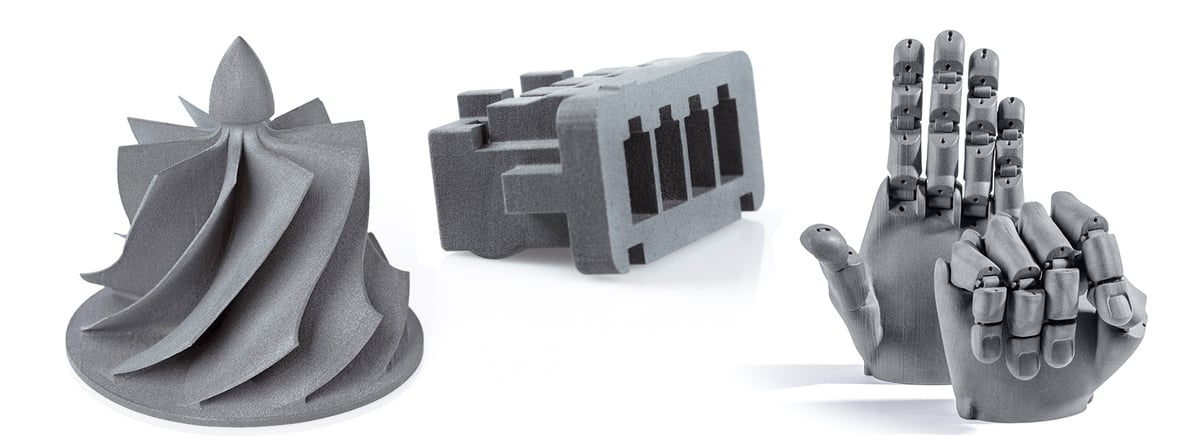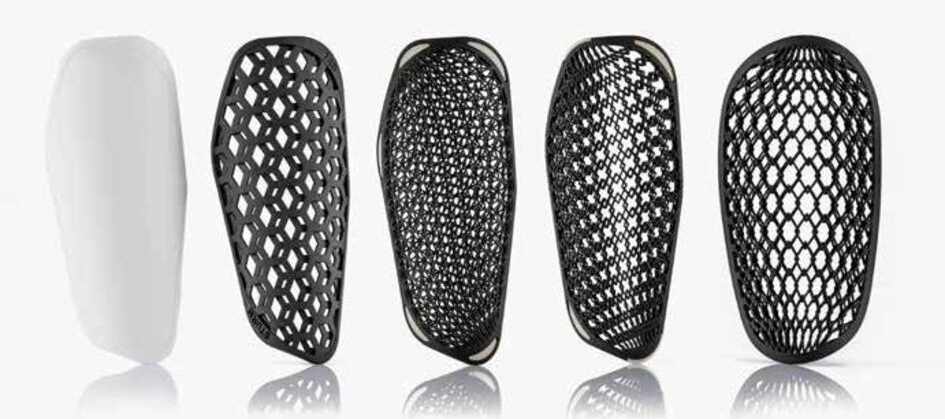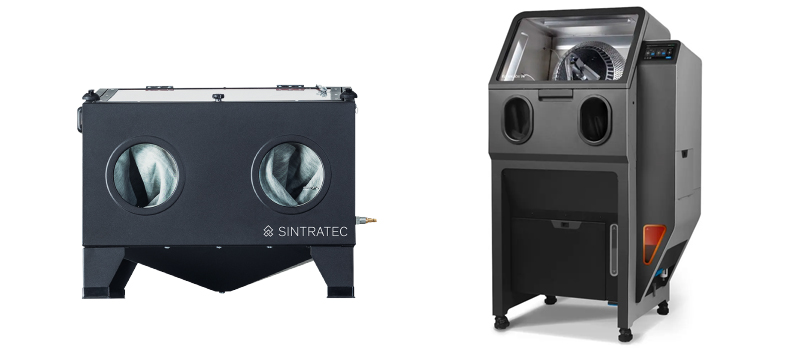Nylon (also known as polyamide or PA) is a resilient and robust material that most people encounter almost every day. It’s in sportswear since it makes textiles stronger. It’s used for luggage wheels for its resistance to abrasion. It’s the intake manifolds of your car and the housings of your electronics because it’s durable, lightweight, and heat resistant. Nylon PA12 is even biocompatible, so you’ll find it used in orthopedic products, such as 3D printed casts and braces.
Used by manufacturers for nearly a century, nylon has become a familiar and reliable choice for 3D printing and is the most common plastic used in additive manufacturing, particularly when you look at the volume of kilograms sold.
Nylon is easy to work with because its melting point is low, yet it produces impressive mechanical properties in 3D prints. The material is chemical resistant, dimensionally stability, and not prone to stress cracking, all of which lead to a huge range of applications in functional prototypes, and end use parts as jigs and fixtures, spare parts, automotive part, sports equipment, and more.
In this guide, we’ll focus in on the nylon variant PA12 (as opposed to PA11 or PA6) and how and why to 3D print with it in its powdered form (it’s far less popular as a filament). But first, let’s take a look at the attractive material characteristics of PA12.
What Is PA12 Nylon?

Why 12? PA12 stands for Polyamide 12, which is a type of thermoplastic polymer belonging to the family of polyamides or nylons. It’s the polymerization of 12-aminododecanoic acid or laurolactam molecules. Polymerization is the chemical process where small molecules, called monomers, join to form larger, more complex structures known as polymers.
Having 12 molecules doesn’t necessarily make PA12 any stronger than PA11 or PA6, two other common nylons in 3D printing, but it does give it a few different characteristics. In general, PA6 is often selected for its high strength and stiffness, while PA11 for its flexibility and chemical resistance. PA12 usually falls in between in terms of characteristics having a balance of strength, toughness, and chemical resistance, making it the most popular nylon.
PA12 Characteristics:
- Strength, toughness, and impact resistance
- Wear resistant
- Chemical resistant
- Thermal stability
- Dimensional stability
- Biocompatible
Not All PA12 Is the Same
Although PA12 refers to a specific type of polymer, there are many variations in formulations and properties. Different brands of PA12 could be made by varying manufacturing processes that impacts the material’s performance (hint: you get what you pay for). Material makers also add various additives to meet specific performance requirements and often have proprietary formulations of their PA12.
In fact, you’ll find some material makers and vendors that don’t identify their nylon as a PA12 (or PA6, or PA11), instead opting to name it something proprietary. For example, DuraForm ProX PA and ProX HST are both PA12 materials developed by 3D Systems for use in their selective laser sintering 3D printing technology. The ProX PA is a food-grade nylon while the ProX HST is recommended by the company for high temperature applications.
Additives for PA12 often improve UV or heat resistance, flame retardancy, and printabiliy. There are also PA12s with reinforcements, such as added carbon or glass fibers to enhance mechanical properties like strength, stiffness, or dimensional stability.

There’s also “sustainable” PA12 in the form of recycled PA12, for example, the PowderMonkey brand rePA12 is a mixture of refurbished PA12 with a portion of virgin PA12 that’s designed for lower-power benchtop SLS printers.
Some PA12 options may claim to have a “high reusability,” which means you can reuse the powder left over from a print at a higher percentage than other PA12. For example, instead of 50% reused powder to 50% virgin powder you can use 60% reused or more. This saves on powder use and costs overall.
Because every PA12 isn’t the same, consider the specific formulation of PA12 and the specific attributes it boasts, along with checking out the technical data sheets that detail the material’s properties.
A typical PA12 would have these general characteristics:
- Ultimate Tensile Strength min/max (MPa): 43/50
- Tensile Modulus Min/Max (MPa): 1550/1850
- Elongation at break min/max (%): 15/25
- Flexural Modulus min/max: 1510/1600
- Part Density (g/cm3): 0.9
- Shore Hardness: Shore D
However, as noted above, manufacturers may formulate their PA12 to be far more flexible than these general characteristics or stiffer, etc.
What Colors Does PA12 Nylon Come In?
PA12 is typically grey or black but can be found in white, which is the best option to add color. This material is easily colored in post-processing, usually using a coloring machine from DyeMansion, but you can also simply apply paint.
Sustainability & Recycling PA12 Nylon

As with any powder bed fusion process, there is lots of unused or leftover material from each 3D printing run. Fortunately, PA12 can be melted and reprocessed multiple times without significant degradation of its properties. This means that your left over powder can all be thrown back into the hopper and used for the next print, but not always without mixing in some fresh, unused powder. There’s also a limited to how many times you can reuse the same powder before your part quality will suffer.
If you’re 3D printing PA12 parts that will be used in a regulated industry or to a certified standard, you may not be able to use anything but 100% virgin powder. However, depending on the mechanical characteristics your part requires, you can go up to 100% reused; yet 60%-70% reused is more typical.
Lowering that remix percentage (or refresh rate) should lower the overall cost of your 3D printing, which is especially important as manufacturers eye it for larger volumes of parts. Keep in mind, however, that refresh rate isn’t just a material issue; your printer also affects your refresh rate.
Recycling Your PA12 Parts
Nylon PA12 is generally recyclable. However, the recyclability of a specific nylon PA12 product depends on several factors, such as its formulation and additives. The recycling process typically involves collecting used nylon PA12 products, melting them down, and reforming the material into new products, but this is only possible when the same type and brand of PA12 is recycled.
Typically you can send your old prototypes and failed prints to an industrial recycling facility.

Sustainable PA12?
In October 2023, Evonik, the Marl, Germany based chemical company, has developed the world’s first powder bed nylon material that substitutes 100% recycled cooking oil for its fossil feedstock, reducing the material’s carbon footprint by 74%. “True circularity is key for being successful in the future,” says Dominic Störkle, head of the additive manufacturing innovation growth field at Evonik. “As a pioneer for polymer-based 3D printing materials, Evonik has developed a formula for its PA12 powders to drive circular plastics economy in additive manufacturing. With the introduction of Infamam eCO PA12, we go far beyond chemistry to start closing the loop, and meet the market’s expectations for a better future.”
Troubleshooting Your PA12 Prints

Although your SLS or MJF 3D printer will have settings for the print process, it isn’t always flawless. Some SLS 3D printers have closed perimeters, meaning you can’t adjust settings, such as for laser power or bed temperature, while other printers enable to you dial-in a wide range of settings. Whether you have a “set-it-and-forget-it” machine or one with open perimeters, you can still encounter print problems. Here are some of the most common.
One problem in SLS printing is called “orange peel”, which is a surface finish print artifact where smooth and flat surfaces look rough and bumpy, often registering with layers. This can happen when the edges of the layer that you’re printing are experiencing a thermal gradient between the sintered and unsintered areas, and they tend to shrink. Over many layers, this causes a bumpy artifact.
This can often be solved by better heat management in the bed or not using the entire volume of the build area, instead printing more in the middle.
Delamination is a print failure when some layers are not fully sintered to previous layers. This can be a problem with the laser. Replacing or sometimes just cleaning the optical elements can help. Dirty optics can also lead to parts that are not as strong as expected.
Warping, or when parts deviate from the model dimensions, is another symptom of heat management. This can happen when the build chamber is not allowed to cool properly or if you unpack parts while the chamber is still hot. It can also happen when there’s insufficient heating during the print, or it could be your design has a variable wall thickness or is too slender overall.
Surface pitting, dimpling, or irregularities can happen when certain part geometries lead to uneven cooling, such as large parts that trap powder inside. It can also be a symptom of a print bed temperature that’s too high.
Post-Processing & Surface Finishing PA12

Once your PA12 parts are 3D printed and cooled down, they are ready to be excavated from the bed of powder. This can be done by hand or with a machine. The unused powder is vacuumed up, sifted, remixed with fresh powder at the desired percentage, and loaded back into the machine or stored. The parts are then cleaned of the excess powder using brushes, air blasters, or tumblers.
If you plan to print frequently, invest in post-processing automation and machines to remix the powder. Loose PA12 powder isn’t toxic, but safety precautions should be taken whenever you’re in contact with loose powder. Enclosed cleaning station like the ones pictured below cut down one the hazards.

What Surface Finishes Are Passible with PA12?
PA12 comes out of the printer with a rough surface that may be desirable for your application. If it isn’t, you have options, some of which may require additional equipment.
- Sanding and Smoothing: Sanding the surface of PA12 parts can help remove layer lines and create a smoother finish. Sanding can be done manually or with tools.
- Painting and Coating: PA12 parts can be painted or coated to add color, improve aesthetics, and provide additional protection. Various paints and coatings, including primers and clear coatings, are compatible with PA12.
- Dyeing: White or light grey PA12 is often dyed, allowing for the customization of the part’s color. Dyeing can be done using specific dyes suitable for polyamide materials.
- Vapor Smoothing: Vapor smoothing involves exposing the PA12 part to a vaporized solvent, which helps melt the outer layer of the print, reducing layer lines and creating a smoother surface finish. This can be done in large batches.

- Heat Treatment: Heat treatment can be applied to PA12 parts to improve their mechanical properties. This may involve exposing the part to elevated temperatures for a controlled period.
- Inserts and Embeddings: Metal inserts such as screw threads, magnets, or other components can be embedded or inserted into 3D-printed PA12 parts during or after printing to add functionality or assembly features.
- Ultrasonic Welding: For joining multiple PA12 parts or components, ultrasonic welding can be used. This method creates a strong bond between the parts by using high-frequency vibrations.
- Electroplating: In some cases, PA12 parts can undergo electroplating processes to apply a thin metallic coating, enhancing their conductivity, appearance, or corrosion resistance.
- Polishing of Satin Finishing: Mechanical or chemical polishing methods can be applied to improve the surface finish of PA12 parts, reducing roughness and enhancing clarity.
Top Brands of PA12 Nylon Powder

Proprietary formulations of nylon PA12 are common throughout the additive manufacturing industry. Several printer manufacturers have fine-tuned the material to their machines while others have “certified” PA12 powder from particular vendors to work on their machines.
For example, the Fuse 1 from Formlabs is not an open-material printer, so Formlabs nylon 12 is your only option. This may be a good thing, though, because there’s far less experimenting and guess work in achieving the desired results. Other SLS printer makers, such as EOS, Sinterit, and 3D Systems all offer their own PA12, while HP offers it’s own PA12 for Multi-Jet Fusion.
If you have an open-material 3D printer, you can be shop around for the PA12 that best suits your application. You could read all of the posted material data sheets or, an easier way is to visit one of the material data portals, such as Senvol. It may not be 100% up to date, but the data there will give you a good starting point.
When it comes to non-branded PA12 for open material systems, check out the new Infinam eCO PA12 powder from material maker Evonik that’s made from 100% recycled cooking oil. It’s other Infinam Polyamide 12 powder has nearly 50 percent less CO2 emissions, Infinam comes is white, natural, and black.
Germany material maker PowderMonkey offers a rePA12 that’s a mixture of refurbished PA12 with a portion of virgin PA12. Another major material maker Arkema offers a nylon 12 called Orgasol Invent PA12 that it says offers a very smooth finish compared to other PA12 powders on the market.
If your PA12 material characteristics are not critical, you can, instead, order sample parts either from your printer maker or a printer service and do your own in-house testing.
PA12 powder for SLS is available from a range of manufacturers. You’ll find materials available from chemical companies, such as Evonik, and materials from printer manufacturers, such as Prodways, that have taken existing materials and tweaked them to perform optimally on their printers.
For Multi Jet Fusion, you’ll get your PA12 material from HP, or one of its distributors, only.
Get Your Parts 3D Printed in PA12 Nylon
If digging through powder beds and spray painting parts is not your cup of tea, there are services that will do it all for you.
Craftcloud for All3DP is a marketplace of services where you upload your part, choose your material and finishes, and receive quotes from service providers that you can then compare.
If you know you want SLS 3D printing, you can find services that specialize in our guide linked below:
If you know you want Multi Jet Fusion 3D printing with PA12, we have a guide to those specialists as well:
__________________
Lead image PA12 parts: Action figure by HP Multi Jet Fusion, pair of valves by Sculpteo, white impellers by 3D Systems, all other parts printed by Weerg.
License: The text of "Complete Guide to Nylon PA12 3D Printing (SLS & MJF)" by All3DP Pro is licensed under a Creative Commons Attribution 4.0 International License.



